
All categories
Featured selections
Trade Assurance
Buyer Central
Help Center
Get the app
Become a supplier

(1572 products available)


































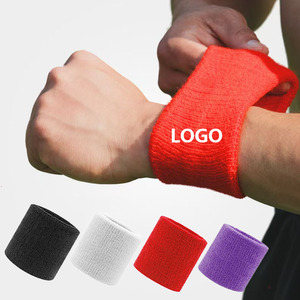
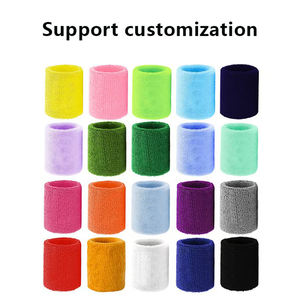

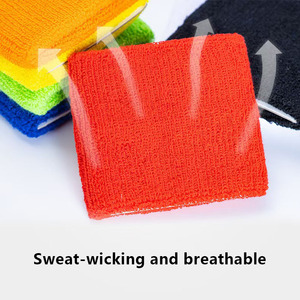
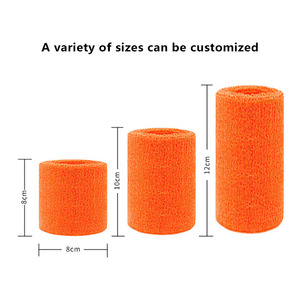
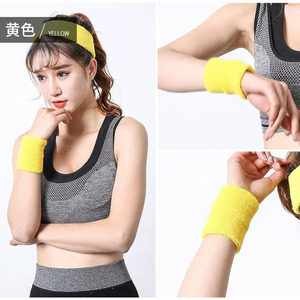






There are several types of athletic wrist bands designed for different activities and preferences. Athletic wrist bands are not just simple bands. Many people combine them with style, and some are used as support for athletes and fitness enthusiasts.
Here are some of the most popular types available:
Fitness Tracker Wrist Bands
Fitness tracker wrist bands are designed for those who want to monitor their physical activities. These wrist bands can track heart rates, sleep patterns, step counts, and other fitness-related data. They are usually made of flexible silicone and are waterproof or water-resistant, allowing users to wear them during any activity. The main objective of these wrist bands is to give out information about the person's overall health and fitness status. So these are great for people who want to work out and get in shape but want to monitor their progress.
Compression Wrist Bands
Compression wrist bands are designed to provide support during physical activities. These wrist bands are made from elastic or spandex materials to help stabilize the wrist joint. This reduces the chances of injury during intense workouts. Athletes, weightlifters, and people who participate in high-impact sports like basketball or racquetball will find compression bands useful, as they can protect the wrist from sprains and strains. As a bonus, the compression wrist bands also make a nice fashion accessory.
Fitness Bands with Cel Phone Holder
As the name suggests with fitness bands with cel phone holder, one can easily strap on a cel phone holder and do his workout, all while listening to his favorite tunes, tracking his progress with several apps, or staying in touch with friends. These wrist bands are useful for people who do not want to keep their phones in their pockets or waste time finding a good place to put their phones while working out. The concept of cel phone holders is further enhanced with additional pouches or waterproof features for added protection.
Elastic Cotton Wrist Bands
Elastic cotton wrist bands are made from a blend of cotton and elastic materials. The main purpose of these wrist bands is to absorb sweat during workouts. These wrist bands are simple and stylish, often used by players in sports like tennis, basketball, or cricket. They help keep the hands dry, preventing the need to stop and wipe sweat from the face. These bands are designed to give maximum comfort, though it is not uncommon for people to have fashion concerns.
Resistance Exercise Band
The resistance exercise band wrist bands are used conjointly during workouts when the band is wrapped around the one's wrist and extended out to other body parts while exercising. Athletes use these bands to build strength, flexibility, and endurance. They are ideal for people doing yoga, Pilates, or strength training, and they add several resistance levels to the workout. Additionally, these bands are lightweight and portable, making them ideal for traveling or exercising anywhere with minimal space.
Athletic sweat bands are designed considering various factors. They are made to serve the needs and functionality of the user. The following are the major design considerations for athletic wristbands:
Material Selection
This is an important element of the design of athletic wrist bands. The fabrics that go into them have to be breathable, stretchable, and durable so they can withstand sweat and intense activities. Cotton and elastic are used in traditional sweat bands, although polyester and spandex blends are commonly found in today's products. In the case of wrist bands that are meant for support or training, heavy-duty materials like nylon or neoprene are often used.
Fit and Comfort
Fitness wrist bands are required to fit snugly, but they should not be tightly wound in one complete turn around the wrist. An efficacious fitness wristband differs from the rest in that it causes no discomfort to the wearer even when used for long hours of training. A spandex-blend wristband gives a lot of stretch and helps the band conform to the different shapes and sizes of the wrist. Some designs also incorporate adjustable features for a better and more comfortable fit.
Moisture-Wicking and Durability
The main challenge people face with wrist bands is that the bands get drenched with sweat quite easily. While some of us will do anything to ensure we look good, doing exercise in damp wrist bands is not preferred by most people. The new generation of athletic wrist bands uses moisture-wicking technologies that draw sweat away from the skin to keep the band and the wrist dry. Durability is also a major concern. The wrist bands have to be durable enough to withstand rugged usage. Hence, materials used for wrist bands are usually durable and stretch-resistant.
Shock-Absorbing Technology
Various wrist bands, particularly those designed to undergo intense physical exercise such as weight lifting, include shock-absorbing materials. These materials help to protect the wrist from damage s during impact exercise or some kind of weightlifting. Further, some advanced designs combine features of compression and shock absorption to provide maximum protection to the wrist while pummeling the body during rigorous workouts.
Breathability and Temperature Control
Breathability factors are integrated into the athletic wrist bands. Most of the wearable gadgets on the market today have inbuilt temperature control technologies to minimize the findings associated with prolonged wear. Incorporating mesh panels or perforated features into the design aids air circulation and temperature regulation, allowing the wearer to remain cool and comfortable throughout the training regimen.
Intense Workouts
Working out can be very tiring; using athletic wrist bands when exercising can make a world of difference. No matter how vigorous or long someone's workout is, these bands ensure comfort and safety. Individuals easily work up a sweat doing cardio, weight training, or HIIT, and if they worry about their wrist bands slipping or causing discomfort, worry no more.
Outside Sports
Outdoor games like tennis, basketball, or cycling, where one's wrist support is often put to the test, demand the use of wrist bands. As the sun beats down and sweat drips, these wristbands keep hands dry, improve grip, and prevent blisters. Several bands are made with UV protection, adding another level of protection to outdoor sports.
Yoga and Pilates
Yoga and Pilates practitioners use resistance bands to enhance their workouts. These wrist bands are great for helping people hold poses or complete movements during their workouts. Comfort is a big selling point of these athletic wrist bands - people can wear them for hours without pain. Also, they come in several cool styles to fit right in at the yoga studio.
Strength Training
Further, in strength training, wrist bands with cel phone holders and those with shock-absorbing technology offer comfort to the participants. The cel phone holder lets one listen to music or track fitness apps without stopping and starting all the time. The shock-absorbing features take the pressure off one's wrists as one lifts a heavier load, which is very good.
Casual Daily Wear
Athletic wrist bands can be conveniently worn during casual occasions. People love throwing them over any outfit as a fashion accessory or giving their style a sporty feel. They also serve a purpose - these bands shield and support wearers throughout the day, whether they're running errands, playing sports, or doing very light workouts.
There are several types of athletic wrist band specifications. Here is what one should consider to choose the perfect product:
Stretch and Fabric Strength
Athletic wrist bands should be made of materials that can stretch significantly, more than thrice their original sizes, without suffering permanent damage or losing their elasticity. Spandex and elastics are known for their high levels of elasticity, which can help keep the wrist band in shape even after extreme pulls and uses.
Circumference Measurement
Wrist bands come in various sizes, and the size of the wrist band depends on the circumferential measurement of the wrist. The size of the wrist bands varies from around six to eight inches in circumference, although many have elastic properties. So, the bands could fit a wider range of circumferential measurements. To get the right fit, one should take a measurement of their wrist and compare it to the size of the band.
Moisture Absorption
The major purpose of performance wrist bands is to absorb body moisture. This attribute is especially important for athletes, as excessive sweating can lead to slippage and decrease grip and support. One way to solve this issue is to determine the level of moisture absorption, as indicated by the inner weather resistance of the fabric used in the construction. The fabrics also contain special weaves or coatings that encourage moisture transfer from the skin to the outside environment.
Weather Resistance
Athletic sweat bands are typically worn in different weather. Most wrist bands are made to withstand either extreme heat or cold. Neoprene wrist bands retain heat during outdoor sports in colder months and help keep the wrist at a comfortable temperature. Conversely, mesh or perforated cotton wrist bands assist in airflow to prevent overheating during summer workouts.
Care and Cleaning
The performance wrist bands are pretty easy to maintain. Most of them can be cleaned with a damp cloth or thrown into a washing machine. However, specialty bands with added shock protection or other technologies may need some special cleaning. These bands contain materials that repel sweat and odor, so less frequent washing is needed.
Wrist bands typically come fitted in a range of sizes. And the wrist band has elasticity; it can stretch to fit a wider range of sizes. However, it is always nice to pick the size that matches the wrist the closest. To do that, one has to measure the circumference of the wrist and then compare that measurement with the size of the band. A perfect fit means that the band will stretch comfortably around the wrist without slipping or being too tight. Some bands have adjustable features, too, so that the fit can be tweaked a bit.
Yes! They are designed to allow air to flow through the material. Many are made with special fabrics that create tiny holes or a mesh pattern to help air circulate. This keeps the skin from getting too hot or damp, which is great when working out or playing games in different weather.
Yes! The athletic wrist bands can be worn every day. Many people choose to wear them as a daily accessory to add a sporty touch to their outfits. Moreover, the wristbands provide comfort and support throughout the day, accommodating various activities like walking, running errands, or light exercising.
These wrist bands are made from very strong materials. That means they can put up with a lot of wear and tear, whether during workouts, playing sports, or even just everyday stuff. Bands made of spandex or elastics are super stretchy but still hold their shape for a long time. Bands made of neoprene and nylon are tough and stand up to sweat, dirt, or anything else that may come their way.
Moisture wicking is a cool feature in many new wrist bands. It's all about using specially made fabrics like polyester or merino wool. These materials pull sweat away from the skin so it can evaporate quickly. The bands tend to get less wet than others during workouts. That makes them comfy to wear and helps them hold up for a long time.